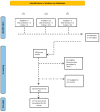Metabolic Dysfunction-Associated Steatotic Liver Disease Induced by Microplastics: An Endpoint in the Liver-Eye Axis
- PMID: 40243419
- PMCID: PMC11989125
- DOI: 10.3390/ijms26072837
Metabolic Dysfunction-Associated Steatotic Liver Disease Induced by Microplastics: An Endpoint in the Liver-Eye Axis
Abstract
There is a significant, rather than just anecdotal, connection between the liver and the eyes. This connection is evident in noticeable cases such as jaundice, where the sclera has a yellow tint. But this can be seen through even more subtle indicators, such as molecules known as hepatokines. This relationship is not merely anecdotal; in some studies, it is referred to as the "liver-eye axis". Ubiquitous environmental contaminants, such as microplastics (MPs), can enter the bloodstream and human body through the conjunctival sac, nasolacrimal duct, and upper respiratory tract mucosa. Once absorbed, these substances can accumulate in various organs and cause harm. Toxic substances from the surface of the eye can lead to local oxidative damage by inducing apoptosis in corneal and conjunctival cells, and irregularly shaped microparticles can exacerbate this effect. Even other toxicants from the ocular surface may be absorbed into the bloodstream and distributed throughout the body. Environmental toxicology presents a challenge because many pollutants can enter the body through the same ocular route as that used by certain medications. Previous research has indicated that the accumulation of MPs may play a major role in the development of chronic liver disease in humans. It is crucial to investigate whether the buildup of MPs in the liver is a potential cause of fibrosis, or simply a consequence of conditions such as cirrhosis and portal hypertension.
Keywords: cellular senescence; cytokines; environmental toxicology; eye; hepatokines; inflammation; liver–eye axis; toxicology.
Conflict of interest statement
The authors declare no conflicts of interest.
Figures


References
-
- European Commission Proposal for a Regulation of the European Parliament and of the Council. [(accessed on 3 March 2025)]. Available online: https://eur-lex.europa.eu/legal-content/EN/TXT/HTML/?uri=CELEX:52022PC0677.
-
- Rani A. Types and Sources of Microplastics; The Ubiquitous Environment Contaminant: A Review. J. Polym. Mater. 2022;39:17–35. doi: 10.32381/JPM.2022.39.1-2.2. - DOI
-
- Mirani A., Kianfar E., Maleknia L., Javanbakht M. Recent advances in nicotine electrochemical biosensors: A review. Case Stud. Chem. Environ. Eng. 2024;9:100753. doi: 10.1016/j.cscee.2024.100753. - DOI
Publication types
MeSH terms
Substances
LinkOut - more resources
Full Text Sources

